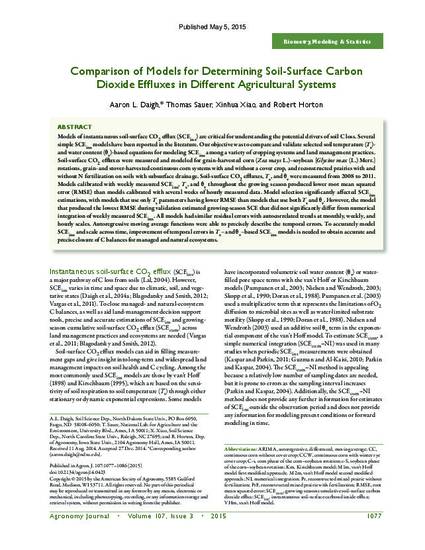
Models of instantaneous soil-surface CO2 efflux (SCEins) are critical for understanding the potential drivers of soil C loss. Several simple SCEins models have been reported in the literature. Our objective was to compare and validate selected soil temperature (Ts)- and water content (θv)-based equations for modeling SCEins among a variety of cropping systems and land management practices. Soil-surface CO2 effluxes were measured and modeled for grain-harvested corn (Zea mays L.)–soybean [Glycine max (L.) Merr.] rotations, grain- and stover-harvested continuous corn systems with and without a cover crop, and reconstructed prairies with and without N fertilization on soils with subsurface drainage. Soil-surface CO2effluxes, Ts, and θv were measured from 2008 to 2011. Models calibrated with weekly measured SCEins, Ts, and θv throughout the growing season produced lower root mean squared error (RMSE) than models calibrated with several weeks of hourly measured data. Model selection significantly affected SCEins estimations, with models that use only Tsparameters having lower RMSE than models that use both Ts and θv. However, the model that produced the lowest RMSE during validation estimated growing-season SCE that did not significantly differ from numerical integration of weekly measured SCEins. All models had similar residual errors with autocorrelated trends at monthly, weekly, and hourly scales. Autoregressive moving average functions were able to precisely describe the temporal errors. To accurately model SCEins and scale across time, improvement of temporal errors in Ts– and θv–based SCEins models is needed to obtain accurate and precise closure of C balances for managed and natural ecosystems.
Available at: http://works.bepress.com/robert-horton/25/

This article is published as Daigh, Aaron L., Thomas Sauer, Xinhua Xiao, and Robert Horton. "Comparison of Models for Determining Soil-Surface Carbon Dioxide Effluxes in Different Agricultural Systems." Agronomy Journal 107, no. 3 (2015): 1077-1086.